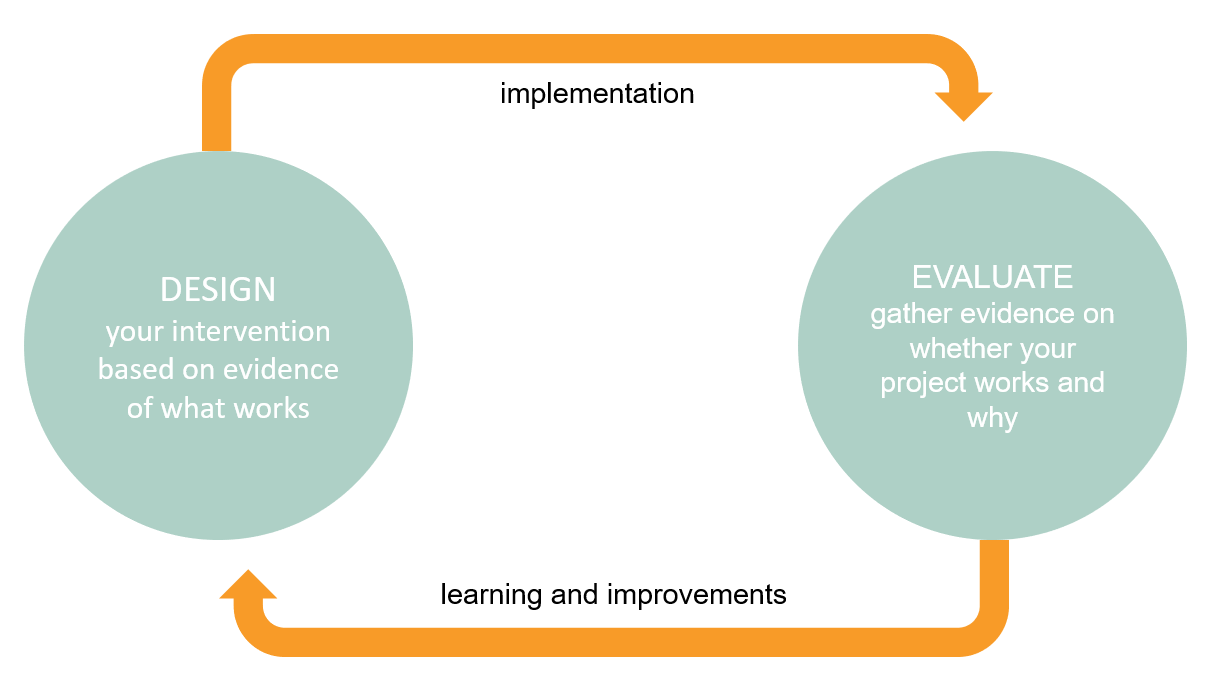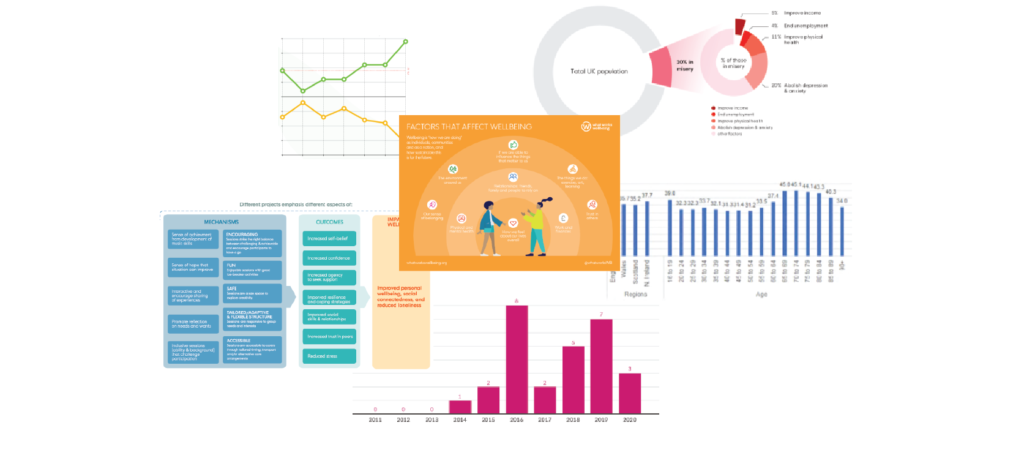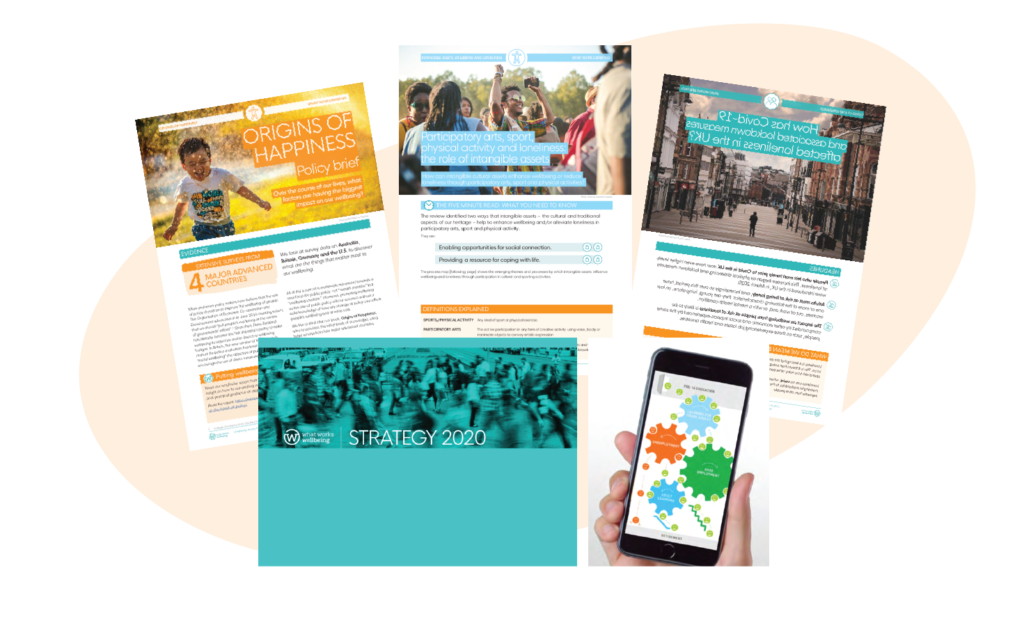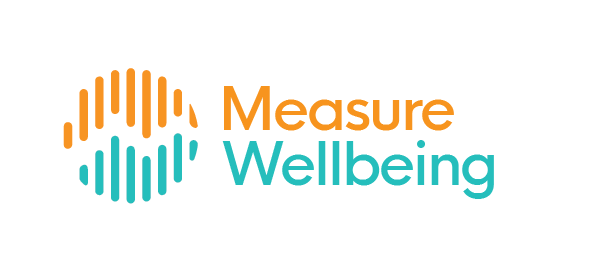Introduction to wellbeing evaluation
This section will:
- Introduce you to wellbeing evaluation, taking you through the steps of carrying out an evaluation with a wellbeing focus.
- Set out key definitions and help you choose your evaluation approach, preparing you for wellbeing measurement (Sections 4, 5, and 6).
What is wellbeing evaluation?
What is evaluation?
Evaluation is the process we use to find out how well an activity or intervention has worked. It’s about gathering evidence to help us judge the value and success of an activity, so that we can learn and make improvements for the future.
You can evaluate whether and how a project worked, as well as how efficiently it was delivered. In this guide we will focus on evaluating outcomes and impact – the change your activities made to the people who took part
Large voluntary, community or social enterprise sector funders, such as the National Lottery Community Fund, define evaluation as:
a process which uses monitoring information and other gathered evidence for learning and improvement, to help us understand how and why we are making a difference and how lessons learnt can be incorporated into future plans.
What is wellbeing evaluation?
A wellbeing evaluation is one in which wellbeing is identified as an important outcome, with wellbeing concepts and measures used to make sense of positive and negative changes that may have come about.
It’s about looking at your activities through a wellbeing lens – and gathering evidence of the changes in wellbeing that may have occurred as a result of your work.
Typically, the process involves using specific approaches and measures that are designed to help you understand changes in wellbeing.
A wellbeing evaluation will usually address one or more of the following questions:
- Did it work? Effectiveness. About the progress you’ve made with your outcomes and theory of change.
- Was it worth it? Efficiency. About how well you’ve used your resources to improve wellbeing.
- What difference it made in the long-term? Impact. About the transformative and longer-term effects of your work.
In the design phase of your project or programme, you will use wellbeing evidence to design a logic model or Theory of Change. You may be using wellbeing concepts and research to explain how your intervention contributes to a chain of results. Wellbeing may be the end result or impact of your work, or an outcome that leads to your final impact.
You will then use recognised wellbeing measures to track and analyse change throughout the course of a project or programme. These measures have been tried and tested in other evaluations and research so you can be confident that they measure what you want them to. In some cases, you will need to calculate the monetary value of your wellbeing outcomes when conducting cost-benefit analysis or comparing programme or policy options through cost-effectiveness analysis. Using recognised measures will help you do that.
Finally, you will report and communicate your findings, including how you are planning to act on what you found. Demonstrating that you improve wellbeing may be a key part of showcasing the quality and value of your work both within your organisation and for external stakeholders, funders and peers.
Five reasons to evaluate your wellbeing impact
-
Wellbeing can be a common measure of success across different activities
Wellbeing concepts and outcomes provide common ground for otherwise different programmes and projects, such as a healthy eating programme and a housing service. Wellbeing measurement can help you look across and compare projects or programmes that have different aims, are run by different organisations or that target different groups of people. This common ground can give you a strong sense of how well different projects are working, and help you decide how best to use your resources to improve wellbeing.
Because wellbeing is measured in national and local surveys, you can also benchmark your findings with this data to help you get a picture of how you are doing compared to a wider population.
-
It captures how people feel about their lives and the wider effects of your activities
Asking people directly how they feel about life, rather than making assumptions about how an activity impacts them, is a powerful, important and democratic way to understand how your intervention is affecting people.
Wellbeing measurement allows you to do this by focusing on subjective measures. You probably already capture objective data (such as how many people gain a qualification through your work), but subjective measures allow you to explain the personal impact these could be having on someone’s confidence, self-esteem, or how they feel about their lives as a whole.
- It can help you understand different impacts on people, and give you unique insights to reduce inequalities
When you measure the wellbeing effects of your activity on individuals, you can understand the different effects your activities could be having on different people with different wellbeing starting points. This can help you identify who might most benefit from your work, and how to target your activities and services to address these inequalities.
The current coronavirus pandemic is an exceptional event that has had an immediate and potentially long-lasting impact on people’s wellbeing and loneliness. Measuring impact during this time may help you uncover the psychological and social effects of the pandemic, and to understand which of your beneficiary groups are most impacted and why.
- Be part of a growing movement and meet the aims of funders and commissioners
Many funders and commissioners have shown their commitment to improving wellbeing through their grant-making activities. By putting wellbeing at the heart of your work, and ensuring you evaluate it properly, you can show that your work fits with these priorities. The concept of social or public value in the UK’s Green Book includes costs and benefits that affect the wellbeing of the population, and a recommendation is made to use subjective wellbeing evidence to capture the direct impacts of policies.
A priority for funders: wellbeing as a strategic and core outcome
- For Sport England, mental wellbeing is a strategic outcome and wellbeing evaluation tools are provided to help grantees measure subjective wellbeing.
- The Heritage Fund requires grantees to demonstrate wellbeing improvements through increased connections and where you live.
- Spirit of 2012 requires grantees to use ONS4 subjective wellbeing measures to track progress of their beneficiaries.
5. Build the broader evidence base of what works
When you evaluate wellbeing, your findings can help feed into a growing body of knowledge on what works to improve wellbeing within specific contexts and populations.
Sharing your wellbeing evaluations will give them a longer life and wider reach, and you’ll provide other organisations with valuable evidence on how to design and carry out interventions effectively. In turn, you’ll be able to learn from your peers and use their evidence to design activities that can make a difference to the people you support.

What makes a good wellbeing evaluation?
A well-planned wellbeing evaluation:
- Uses wellbeing theory, concepts and research. Including recognised and appropriate wellbeing concepts and evidence of what works. Having a logical, evidence-informed and clear Theory of Change will allow you to describe and measure the ways in which your activities are linked to wellbeing impacts.
- Uses credible measures to understand and compare impact. By including appropriate outcome and impact indicators in your evaluation framework, you’ll be able to gather the most meaningful information on the wellbeing improvements you aim to bring about.
You will also need to think about whether the measures are sensitive to the type of wellbeing changes you want to measure and whether they can pick up the changes within your chosen timeframe. You can also check whether the measures are used in national, regional or local surveys so you can benchmark effectively by comparing your performance to others in the UK.
Analysing, reporting and disseminating findings
Once you have analysed your results, you will need to present them to your key audience. The next steps will be to:
- Decide on an appropriate format
- Make recommendations for action
- Develop a plan to share your learning
There are three types of reporting format you may want to consider:
1.Visual formats – good for communicating lots of information and you can use them alongside other formats. Some examples are infographics, posters or data dashboards.

- Spoken formats – good for engaging your audience and presenting the perspectives of your beneficiaries. Some examples are videos, presentations and podcasts.
- Written formats – good for providing detailed descriptions of your evaluation findings and recommendations. Some examples are: summary reports, blog posts or traditional evaluation reports.
Traditional written reports
If you are reporting your wellbeing findings in a more ‘traditional’ written evaluation report, make sure you include the following sections:
- Executive summary: a synopsis of your key findings and recommendations.
- Introduction: a brief description of what you are evaluating, the purpose of your evaluation and the methods you have used (eg surveys, interviews).
- Findings and discussion: information on what you delivered, how you delivered it and what outcomes occurred.
- Recommendations: actions that need to be taken to respond to the evaluation findings.

For more guidance on how to report and use your findings, go to NCVO Know-How Non-profit for advice and guidance on:
In this section you learned:
- What we mean by wellbeing evaluation
- Five reasons to evaluate wellbeing
- What makes a good wellbeing evaluation
Next you’ll learn how to plan your wellbeing evaluation
